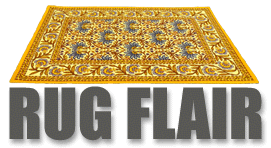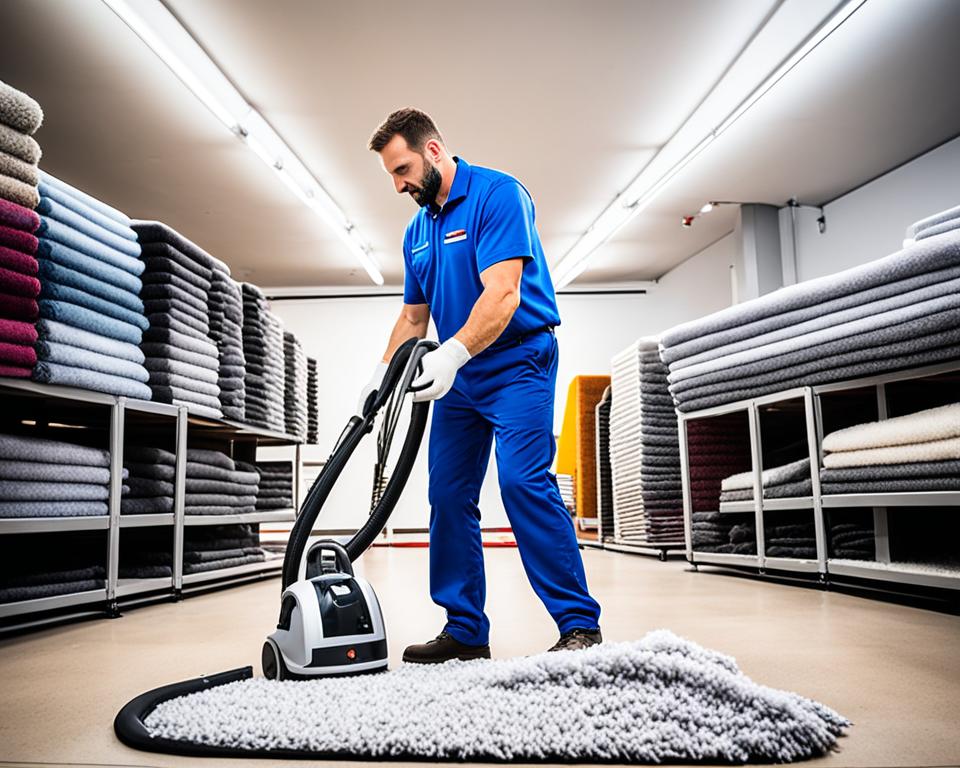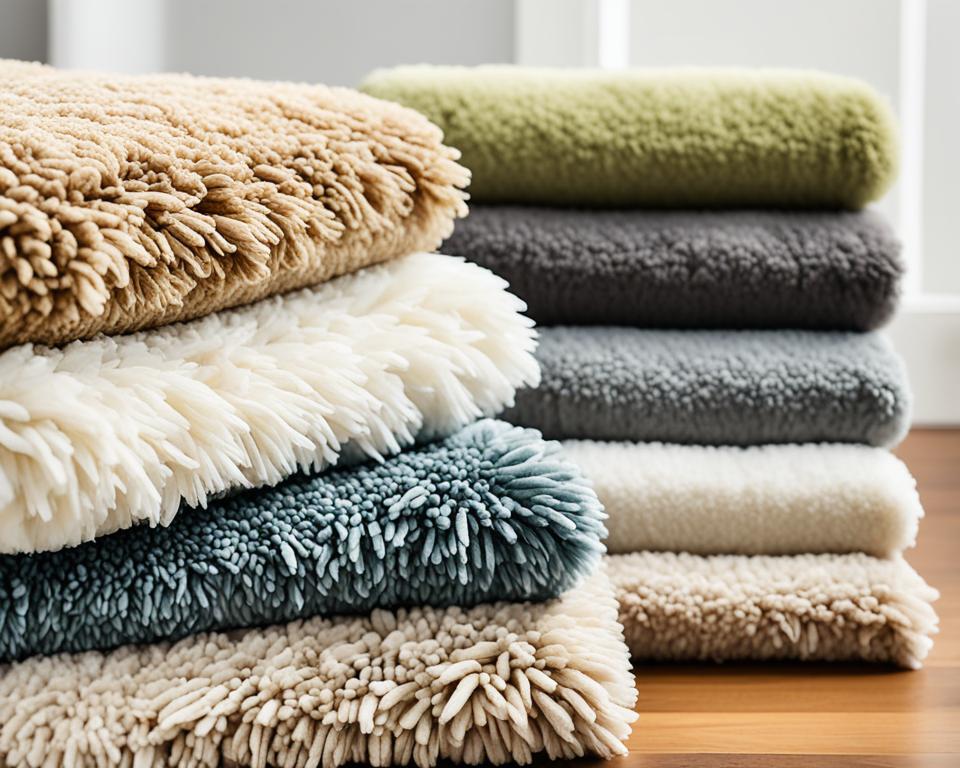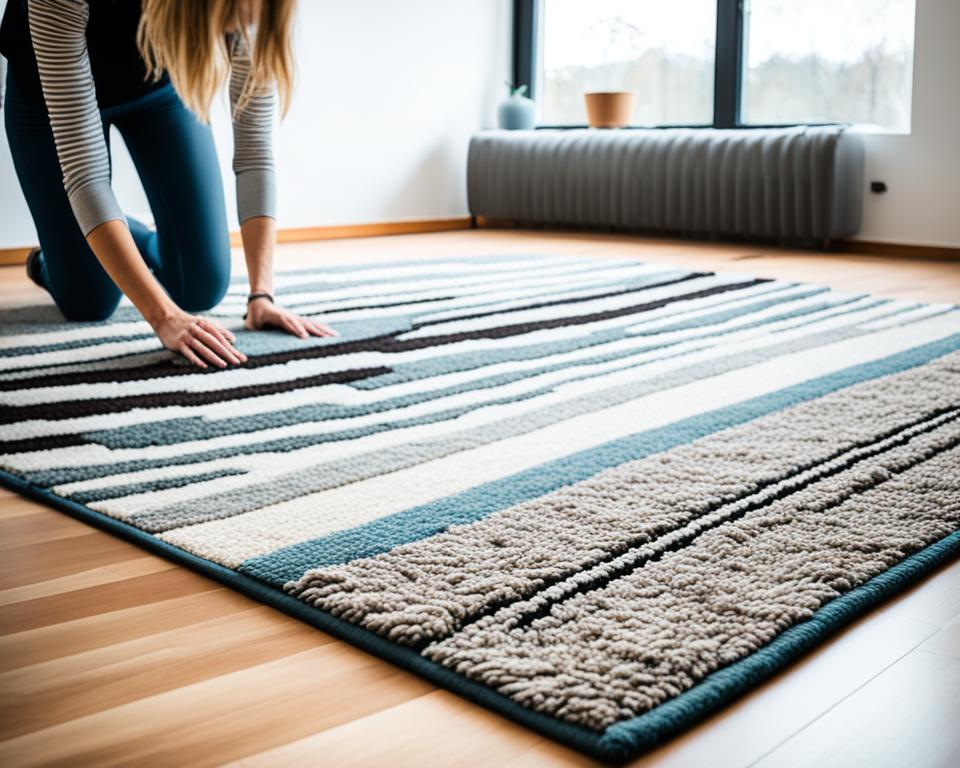Embarking on the quest for home cleanliness, you may wonder, “Can rugs be dry cleaned?” It’s a common question, and the answer isn’t always a simple ‘yes’ or ‘no.’ As you consider maintaining the splendor of your cherished rugs, it’s essential to navigate the complexities of dry cleaning rugs. The fabrics and hues that give life to your décor demand careful cleaning methods to prevent damage and retain vibrancy. Moreover, understanding expert cleaning tips can revive your rug’s fibers post-cleaning, ensuring rug maintenance is both effective and safe.
Key Takeaways
- Dry cleaning isn’t suitable for all rug types due to potential chemical damage.
- Revitalize compacted fibers after cleaning with vacuuming or soft-bristled brushing.
- Expert cleaning tips enhance long-term home cleanliness and rug maintenance.
- Preserving beauty and extending rug longevity is pivotal when selecting a cleaning method.
- Consulting care labels and professionals ensures your rug’s integrity post-cleaning.
- The right knowledge can maintain your rugs’ vibrant look and feel for years to come.
Understanding Rug Materials and Dry Cleaning Feasibility
When it comes to preserving the beauty of your area rugs, understanding the type of fibers they are made from is crucial. Different materials have different cleaning requirements, especially when considering natural vs. synthetic fibers. This knowledge determines whether you can safely dry clean area rugs or if another cleaning method is more appropriate.
Natural vs. Synthetic Fibers
Natural fibers, such as wool, cotton, jute, and sisal, respond differently to cleaning methods compared to synthetic ones like nylon or polyester. While synthetic fibers can often withstand dry cleaning vs steam cleaning rugs, natural fibers require more gentle care. The risk of damage from harsh chemicals or high temperatures means that being well-informed about your rug’s material composition is key to choosing the right cleaning method.
Special Considerations for Jute and Sisal Rugs
If you have jute or sisal rugs, you’ll need to take extra precautions. These natural fibers are particularly sensitive to moisture and can be easily damaged by traditional wet cleaning methods. Browning, shrinkage, and warping are all potential consequences if these rugs are exposed to too much water. Routine maintenance should include vacuuming and dusting, rather than relying on methods that could compromise the integrity of the rugs.
For an effective deep clean without the risks of wet cleaning, shake out any loose debris and dust from your jute or sisal rug outdoors. Then, evenly apply a dry rug shampoo or baking soda to the surface, allowing it to sit for several hours to fully absorb odors and dirt. Vacuum the rug thoroughly to finish, making sure to omit the beater bars to avoid damaging the fibers.
When tackling stains on these natural fiber rugs, consider using dry or powder-based cleaning solutions that do not introduce additional moisture. In the case of a spill, blotting—rather than scrubbing—is the best immediate action to limit the spread and ingraining of the substance.
Overall, your approach to cleaning will vary depending on the type of material your rug is made from. By taking the time to understand the needs of natural fibers versus synthetic ones, you make informed decisions that will prolong the life and appearance of your floor coverings. Be sure to carefully read the care labels and when in doubt, consult with a professional about the best way to dry clean area rugs to maintain their structural and aesthetic quality.
Why Regular Vacuuming Is Crucial for Rug Maintenance
When it comes to cleaning rugs at home, one might underestimate the sheer power of the vacuum. Yet, the act of regular vacuuming stands as a cornerstone in rug care instructions, ensuring the longevity and aesthetic vitality of your area rugs. Unlike other maintenance methods, vacuuming is gentle, efficient, and profoundly transformative for all types of rugs.
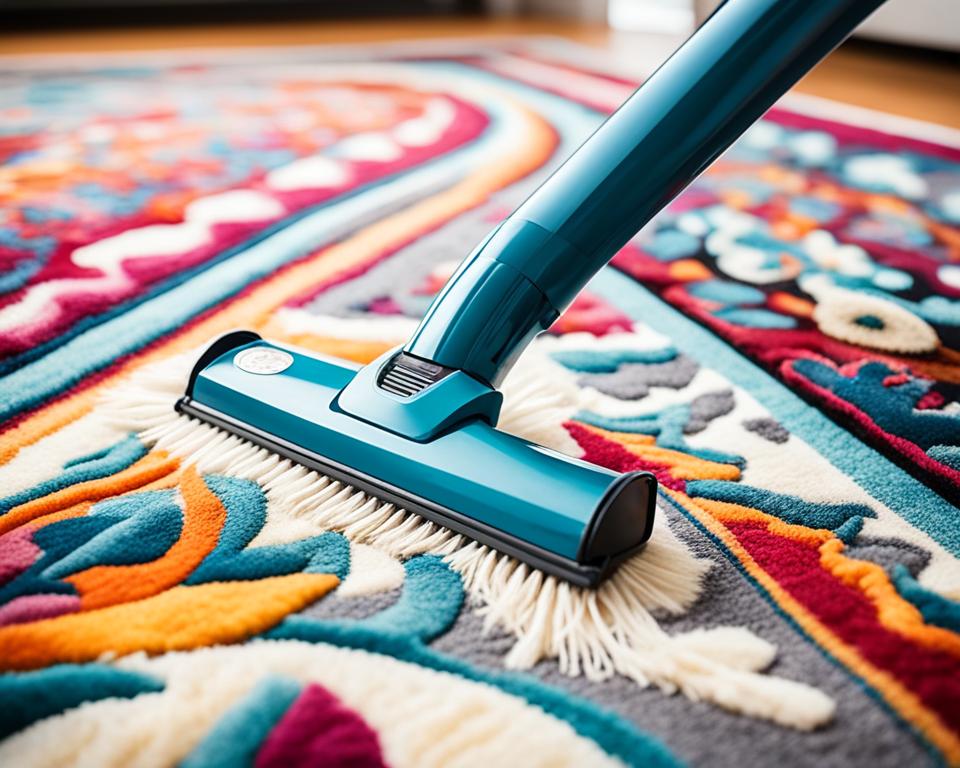
If your home is graced with open-weave rugs like jute or sisal, the absence of beater bars during vacuuming becomes non-negotiable. The intricate weaves of these rugs can trap a considerable amount of dirt and dust, yet they’re also susceptible to the aggressive bristles of standard vacuum attachments. This is where vacuuming without beater bars unveils its significance, enabling you to restore the material without causing any undue strain.
During the cleaning process, threads and fibers can get compacted and squished. Revive them by running a vacuum over the now-dry rug, or brush with a soft-bristled brush.
Imagine rejuvenating your rug, not just cleaning it. That’s what regular vacuuming offers—a chance to maintain the rug’s vibrant look and tactile delight with every pass of the vacuum. It’s an indulgence in the best way to clean rugs, marrying simplicity with profound care.
- Vacuuming removes unseen dirt and particles that can degrade rug fibers over time.
- A careful vacuum can refresh a rug’s look and heighten its texture for a plush feel.
- Specific vacuuming techniques are vital for different rug types to prevent damage.
- Maintaining a vacuuming routine contributes significantly to your home’s cleanliness.
So, as you develop an affectionate ritual of rug maintenance, remember this: Vacuuming is not just a task; it’s a preserver of memories and a curator of the cozy ambiance that makes your house a home.
Can Rugs Be Dry Cleaned?
Embarking on a journey of rug maintenance, many homeowners ponder if can rugs be dry cleaned. While certain types of rugs may tolerate the dry cleaning process, it’s essential to understand the various factors that impact this cleaning method. In the domain of home décor, the goal is always to maintain the aesthetic and longevity of your rugs without causing inadvertent harm.
The Process of Dry Cleaning Rugs
When considering the dry cleaning of your treasured rugs, it’s the subtleties in the procedure that matters. Unlike traditional laundering, dry cleaning utilizes chemicals to extract dirt and stains from textiles. The term ‘dry’ could be misleading as it doesn’t imply an absence of liquids, but rather the avoidance of water. This technique can be particularly advantageous for rugs where water-based cleaning could lead to damage or drastic color bleeding.
Potential Risks Associated with Dry Cleaning Chemicals
Despite the efficacy of dry cleaning chemicals in eliminating grime, these potent substances can sometimes pose a threat to the delicate nature of certain rug materials. The inherent risks range from degradation of the rug fibers to the unsettling chance of triggering allergic reactions among sensitive individuals.
| Rug Type | Suitable Dry Cleaning | Risks with Dry Cleaning Chemicals |
|---|---|---|
| Wool | Limited suitability. Consult care labels or professionals. | Chemicals may cause shrinking, color bleeding, texture alteration. |
| Silk | Not recommended due to fragility. | High risk of damaging delicate fibers and causing color changes. |
| Synthetic (Polyester, Nylon) | Generally considered safe. | Potential for chemical residue buildup, affecting rug longevity. |
| Natural Plant Fibers (Jute, Sisal) | Highly discouraged. Alternative methods preferred. | Risk of water damage, browning, and texture distortion. |
Before making the decision to dry clean your rugs, it’s vital to engage in rug material care due diligence. Carefully scrutinize care labels and, when in question, lean on the expertise of professionals. This cautious approach will ensure that your rug doesn’t only emerge clean, but also unscathed and as vibrant as it was the day you brought it home.
Alternatives to Dry Cleaning: DIY Solutions for Home Rug Care
Stepping into the realm of self-sufficient home care, taking the DIY route to cleaning rugs at home offers a fulfilling sense of accomplishment and control over the substances that come into contact with your living spaces. Whether you’re trying to preserve the integrity of your rug’s fibers or simply extend the time between professional rug cleaning appointments, these alternatives beckon with their simplicity and effectiveness.
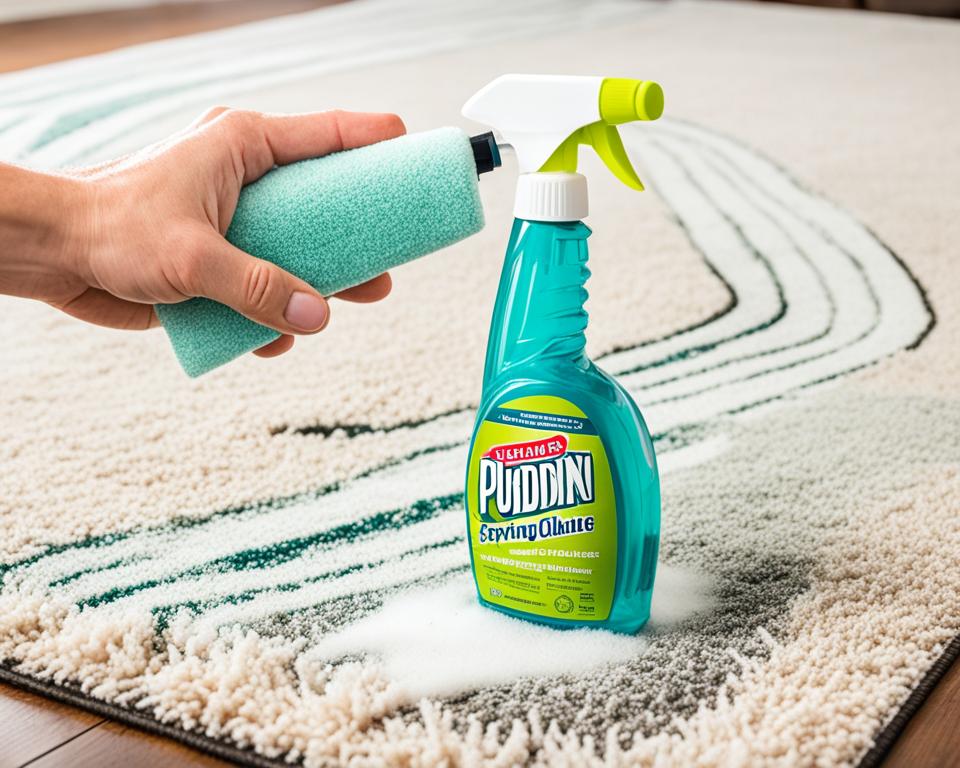
Simple Cleaning Tips for Area Rugs
For those new to the DIY cleaning scene or seasoned pros looking for a refresher, remember that your area rug can be a focal point of cleanliness and comfort in your home. Here is a basic protocol to follow:
- Always start with a thorough vacuuming to remove surface dust and debris—this can be half the battle.
- In case of spills, act swiftly to dab and blot the area gently with a clean absorbent cloth.
- To tackle general grime, a mild detergent and warm water solution can do wonders. Just ensure you rinse thoroughly and dry completely to avoid mildew.
Using Household Items for Stain Removal
Turning to the kitchen cupboard or utility closet, it’s surprising how many household items double as effective rug-cleaning agents. They can provide quick fixes to incidental messes and prevent stains from setting in:
For stains like spilled wine or a dropped bit of chocolate, reach for the unassuming power of baking soda or white vinegar, your natural deodorizing and stain-lifting allies.
- Hydrogen Peroxide: a light spritz can brighten up and break down more stubborn stains like blood or red wine.
- Club Soda: ideal for lighter spills, club soda’s carbonation can lift away a surprising array of stains.
- Rocco & Roxie Professional Strength Strain & Odor Eliminator: this over-the-counter marvel can rescue your rug from pet-related mishaps.
Embracing these rug maintenance tips can lead to a more vibrant living space and prolong the splendor of your rugs. Remember, for extensive damage or deeply set stains, reaching out to a professional may be the prudent choice. But for everyday upkeep and immediate accidents, these DIY solutions stand ready at your command.
Professional Rug Cleaning vs. At-Home Dry Cleaning Methods
As you traverse the journey of rug upkeep, weighing the options between professional rug cleaning services and cleaning rugs at home becomes a vital part of preserving your textiles. When the question arises, “can rugs be dry cleaned?” you are faced with choices that could significantly affect the lifespan and appearance of your floor covering treasures.
Breaking down the intricacies between these methodologies, it’s clear that professional rug cleaning is distinctive in its approach. Specialized in handling a myriad of rug types, professional cleaners meticulously gauge the fiber’s resilience, the dye’s stability, and the rug’s overall condition. This level of scrutiny is paired with tailor-made cleaning regimens that preserve the rug’s integrity, a forte of professional services that standard at-home dry cleaning methods can seldom match.
Professional rug cleaners operate with a nuanced understanding that ensures your rugs emerge not only spotless but safeguarded against contaminants and allergens. They extract dirt from the deepest fibers and pay keen attention to preserve the rich colors and soft textures that make your rugs special.
Whereas home dry cleaning kits may offer convenience, they lack the customized care and expertise that rugs often require. The disparity between the at-home and professional cleaning experience is stark and warrants serious consideration for the conscientious homeowner.
| Cleaning Method | Main Advantages | Potential Limitations |
|---|---|---|
| Professional Rug Cleaning | Custom cleaning plans, deep fiber cleaning, expertise in various materials and dyes. | May require transportation of rug, potentially higher costs. |
| At-Home Dry Cleaning | Convenient, immediate treatment of spills and stains. | Limited cleaning efficacy, risk of inappropriate chemical use, lack of deep clean. |
Considering the detailed table above, you may discern the care your rugs necessitate. Whether bolstered by professionals or approached with a DIY fervor, your choices in rug maintenance echo a commitment to the enduring allure of each carefully woven thread. Ultimately, seeking the guidance of experts empowers you with the assurance that your rugs are not merely cleaned—but cherished and conserved.
The Delicate Art of Persian and Oriental Rug Cleaning
Steeped in tradition and heritage, Persian and Oriental rugs are not simply home decor but cherished narratives woven into patterns and symbols that have been passed through generations. The elaborate rug dyes and weaves of these textiles require a tender touch and expertise to maintain their beauty and longevity. Let’s explore the care needed in handling delicate fibers typically found in such artisanal pieces.
The Importance of Understanding Rug Dyes and Weaves
Every Persian and Oriental rug tells a story, depicted through the intricate dyes and unique weaves that make up its design. These elements are not only a testament to the rug’s craftsmanship but also to its specific care requirements. Knowing the type of dyes used—whether they are natural or synthetic—can significantly impact the cleaning process, as some dyes may bleed if not treated appropriately. Similarly, handling delicate fibers is critical as the weave of the rug can dictate the best cleaning method to prevent unraveling or damage.
Expert Tips for Handling Delicate Fibers
When it’s time to clean your Persian or Oriental rug, the approach should be gentle and considered. Preserve the integrity of your decorative investment with these expert tips:
- Check the care label or consult with a professional for specific Persian and Oriental rug cleaning instructions.
- Avoid harsh chemicals that could compromise the intricacies of the rug dyes and weaves.
- For spot cleaning, use a small amount of water and scrub gently to prevent damage. Remember to test on a discreet part of the rug first.
- After using any soap, be sure to rinse with clean water and dab dry to remove any remaining residue.
- If you’re uncertain about the best course of action, it’s always safest to contact a reputable expert specializing in handling delicate fibers.
Ultimately, the careful upkeep of your Persian and Oriental rugs can not only clean but can also protect these treasures for future enjoyment. Now that you’re equipped with knowledge and tips, you can approach rug maintenance with the confidence of a connoisseur.
Cleaning Large Area Rugs at Home: A Step-by-Step Guide
Unlock the secrets to cleaning large area rugs with confidence and ease. From the comfort of your home, you can achieve professional-level results and elevate your home cleanliness to new heights. Step by step, this guide will walk you through the best way to clean rugs, ensuring your large area rugs continue to complement your living space beautifully.
Preparing Your Rug for Cleaning
To begin the cleaning process, start with essential preparations that will set the stage for a successful deep-cleaning experience. Here’s what you need to do:
- Clear the area: Move any furniture off the rug to ensure you have uninterrupted access to the entire surface.
- Transport with care: For easier handling, roll up your large area rug and take it outdoors where there’s ample space for cleaning.
- Remove loose debris: Begin with a thorough vacuuming on both sides of the rug to eliminate dust and dirt, paving the way for more efficient deep cleaning.
Effective Techniques for Deep-Cleaning Large Rugs
Once your rug is prepared, it’s time to dive into the deep-cleaning process. These techniques will help you carefully and effectively coax out the embedded dirt that simple vacuuming can’t reach.
Tip: Always test any cleaning solutions on a small, inconspicuous area of your rug to check for colorfastness and prevent unwanted surprises.
| Step | Description | Benefit |
|---|---|---|
| 1. Apply Cleaning Solution | Mix a gentle, rug-friendly cleaner with warm water and apply it to the surface with a sponge or soft brush. | Targets deep-set grime without harming rug fibers. |
| 2. Rinse Thoroughly | After working the solution into the rug, use a garden hose to rinse until no soapy residue remains. | Ensures all cleaning agents are removed, preventing attraction of future dirt. |
| 3. Remove Excess Water | Wring out the rug as much as possible to expedite the drying process. | Minimizes drying time and reduces the risk of mildew or odor development. |
| 4. Proper Drying | Lay the rug flat on a clean surface or hang it up to air dry, avoiding direct sunlight to prevent color fading. | Preserves the rug’s texture and vibrancy while ensuring complete dryness. |
Drying can take between one to two days, depending on humidity and air circulation. Once your rug is dry, give it one final vacuum to fluff up the fibers and admire the refreshed, vibrant appearance of your area rug. By following this guide, you will discover that cleaning large area rugs at home can be an effective and satisfying task, fundamental to maintaining your home’s overall cleanliness and comfort.
Dry Cleaning vs. Steam Cleaning Rugs: What’s the Difference?
When faced with a decision on whether can rugs be dry cleaned or if steam cleaning is the better option, it’s important to understand the distinct processes each one entails. Dry cleaning rugs involves the use of solvents that dissolve dirt and grime without the need for water. This method is incredibly effective at getting out tough stains, however, it must be noted that it can expose your rugs to harsh chemicals which might not be ideal for all materials.
On the other hand, dry cleaning vs steam cleaning rugs offers a comparison point, as steam cleaning utilizes high heat to penetrate deep into rug fibers, knocking loose any embedded dirt, while sanitizing your rugs as it goes. Yet, the intense heat may not be suitable for rugs with delicate dyes that could fade or bleed. Deciding which method to use often boils down to the specific type of rug fabric you’re dealing with and the nature of the stains or dirt embedded within it.
As you deliberate these options, keep in mind that both methods have their merits and can yield impressive results when utilized appropriately. If you’re unsure of the method to apply to your unique rug situation, consider consulting with a professional cleaner to avoid any irreversible damage. Whether you choose to opt for dry cleaning or steam cleaning, being well-informed will empower you to maintain your rugs in pristine condition for years to come.
FAQ
Can rugs be dry cleaned?
Yes, many rugs can be dry cleaned, but it’s important to consider the rug’s material and care instructions first, as not all rugs are suitable for dry cleaning.
What should I know about dry cleaning rugs with natural vs. synthetic fibers?
Natural fibers, such as jute and sisal, can be damaged by wet cleaning and are often better suited to dry cleaning methods. Synthetic fibers may be more tolerant to a variety of cleaning methods, including both dry and wet cleaning.
Are there special considerations for dry cleaning jute and sisal rugs?
Yes, jute and sisal rugs should not be wet cleaned as this may cause damage like browning. They require regular vacuuming, dusting, and the use of dry solutions for stains and deep cleaning.
Why is regular vacuuming important for maintaining my rug?
Regular vacuuming removes dirt, dust, and debris that can deteriorate rug fibers over time. It helps preserve the rug’s appearance and extends its longevity.
Can the chemicals used in dry cleaning rugs be harmful?
Potentially, yes. Dry cleaning chemicals can damage delicate rug materials and dyes, and may also cause allergic reactions in some individuals. It’s vital to ensure the chemicals are safe for use on your specific rug.
What are some simple DIY rug cleaning tips?
For area rug maintenance, you can use a mixture of soap and water for most stains, hydrogen peroxide for tougher stains, and club soda for lighter stains.
Can household items be effective for rug stain removal?
Absolutely, items like baking soda can help remove odors, while club soda and vinegar can be used on certain types of stains. Always test these solutions on a small area first.
How does professional rug cleaning differ from at-home dry cleaning methods?
Professional rug cleaning often involves a customized approach tailored to your rug’s material and condition, while at-home methods are more generalized and may not account for the rug’s specific requirements.
What should I know about cleaning delicate fibers in Persian and Oriental rugs?
Persian and Oriental rugs require gentle cleaning techniques. Avoid harsh chemicals, and always test any cleaning solution on a small area first. For difficult cases, consulting with a professional is recommended.
How do I prepare my large area rug for home cleaning?
Start by moving the rug outside, roll it for transport, and vacuum thoroughly to remove surface debris. Then, proceed with your chosen cleaning method.
What techniques are effective for deep-cleaning large area rugs at home?
Use tested cleaning solutions and apply them with a sponge or brush, rinse thoroughly, and ensure the rug is completely dry before bringing it back inside.
What’s the difference between dry cleaning and steam cleaning rugs?
Dry cleaning uses chemical solvents to clean rugs without water, while steam cleaning uses high-temperature steam. Each method has its risks and may not be suitable for all rug types, especially those with delicate materials.
